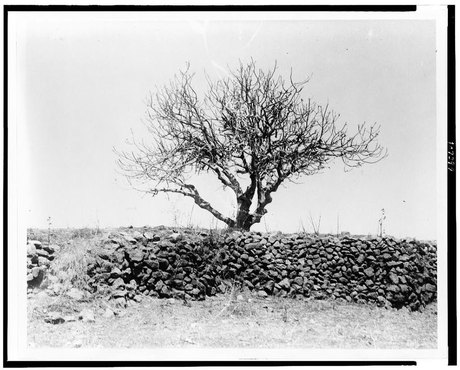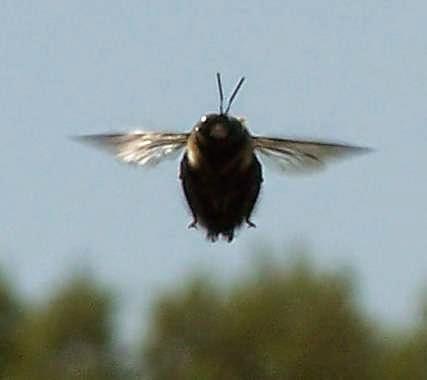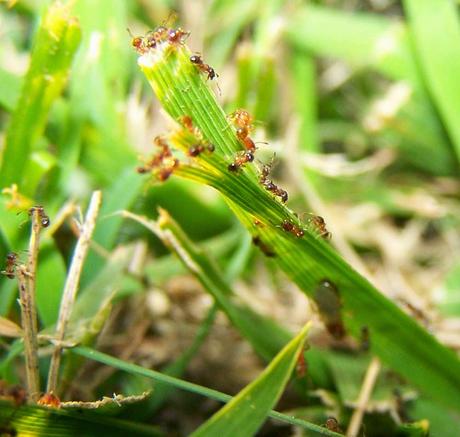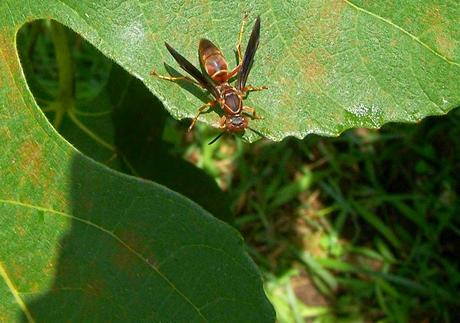I walked around the yard and over to the pasture and I pass wasps busily building nests, carpenter bees buzzing, bumble bees in the wildflowers, fleas trying to get on my cats, flies, and moths circling the spotlight.
When I came back inside, I settled down to Facebook to see what was what and who was who. People like to post photos with quotes on them. Often, far too often, the quote is from someone who is a false teacher or at least, on the path and is currently not highly trustworthy. I've often wondered how far to go in adding my 2¢.
Today I made three comments regarding the Truth, which were not totally affirming of the posted quote but offered an alternate view. I thought of the term "gadfly." According to Wikipedia,
A gadfly is a person who upsets the status quo by posing upsetting or novel questions.I don't see my role as that, to purposely whip people into a fury, but often in employing the gift of discernment the results evidenced are emotions that range from irritation to fury. Sometimes people are stung when you offer that their favorite teacher is really a false teacher, or their pet doctrine is unbiblical, or their method isn't aligned with what the bible says. Some examples of gadfly questions or statements might be:
The term "gadfly" was used by Plato in the Apology to describe Socrates's relationship of uncomfortable goad to the Athenian political scene, which he compared to a slow and dimwitted horse.During his defense when on trial for his life, Socrates, according to Plato's writings, pointed out that dissent, like the gadfly, was easy to swat, but the cost to society of silencing individuals who were irritating could be very high. "If you kill a man like me, you will injure yourselves more than you will injure me," because his role was that of a gadfly, "to sting people and whip them into a fury, all in the service of truth."
- Are you sure you want to continue doing altar calls?
- Did you know that Billy Graham preached a different Gospel?
- Is Beth Moore the best curriculum we can find or are there others that would be more biblical?
- I don't think free will means what you think it means
- Is it possible that LifeWay has become untrustworthy and sells things with heretical doctrine in them?
"Egypt is a beautiful heifer, but a gadfly is coming against her from the north." (NIV)
Yes, the gadfly cometh. LOL. I got to thinking about animals in the Bible in general. We think of leviathan, or the great fish that swallowed Jonah, or the bears that tore up the mocking boys, or the lions that David fought, but what of lowly insects?

Locust
The bible mentions them frequently. Some of the plagues God put on Pharaoh and his people were insects. The Plague of Gnats, the Plague of Flies (Exodus 8), the Plague of Locusts (Exodus 10).
John the Baptist ate wild honey and locusts in the desert. (Matthew 3:4). God even likened Himself to a moth once. (Hosea 5:12). But what of other insects in the Bible?
INSECTS: we find at least 23 names of insects or words referring to them: ant, bald locust, bee, beetle, cankerworm, caterpillar, creeping thing, cricket, crimson, flea, fly, gnat, grasshopper, honey, hornet, locust, louse, (lice), moth, palmer-worm, sandfly, scarlet-worm, silk-worm.
These can be referred to about 12 insects, which, arranged systematically, are:
Hymenoptera, ant, bee, hornet;
Siphonaplera, flea;
Diplera, fly;
Rhynchota, louse, scarlet-worm;
Orthoptera, several kinds of grasshoppers and locusts.
The word “worm” refers not only to the scarlet-worm, but to various larvae of Lepidoptera, Coleoptera, and Diptera. “Creeping things” refers indefinitely to insects, reptiles, and beasts. In the list of 23 names given above honey and bee refer to one insect, as do crimson and scarlet. Sandfly has no place if “lice” be retained in Ex 8:16 ff. Bald locust, beetle, canker-worm, cricket, and palmer-worm probably all denote various kinds of grasshoppers and locusts.
The Eng. language seems to lack appropriate names for different kinds of grasshoppers and locusts, and it is difficult to suggest any names to take the places of those against which these criticisms are directed. See under the names of the respective insects.
See also SCORPION and SPIDER, which are not included here because they are not strictly insects.
Source: Day, A. E. (1915). Insects. In J. Orr, J. L. Nuelsen, E. Y. Mullins, & M. O. Evans (Eds.), The International Standard Bible Encyclopaedia (Vol. 1–5, p. 1473). Chicago: The Howard-Severance Company.

In 1915, swarms of locusts devastated Palestine. An American Colony photographer took this picture of a fig tree that the locusts had stripped bare. The picture starkly illustrates the kind of damage these insects would have inflicted during the locust plague in Egypt and in the other instances that the Bible mentions of locust swarms. Exod 10:4–19, Deut 28:38, Joel 1:4, Joel 2:25, Amos 7:1, Rev 9:3–7
Image by Matson Photo Service, from Library of Congress. License: Public Domain

The Bitterness of Pharaoh
God used insects as the dividing line to show Pharaoh Who is in charge of creation.
After the third and fourth plagues there could no longer be any doubt as to the power of Moses, and very little doubt as to his divine authority. When the plague of lice came, Pharaoh’s magicians tried to imitate it and failed, and they confessed to him that they believed that Moses had the power of a god. In the plague of flies, Moses for the first time drew a dividing line: the flies did not come into the houses of the Israelites; they pestered only the Egyptians.
Strangely indeed must Pharaoh have felt his position. He, the absolute monarch who had always had his way in everything and been all powerful, who was called a god by his people, he was now told by his own learned men that there was another more powerful than he, that there was a real God acting against him, and that he must yield. The Bible and its Story, Volume 2: The Law, Leviticus to Deuteronomy, Horne, Charles, Bewer, Julius
In Isaiah 7:18 we read,
In that day the LORD will whistle for the fly that is at the end of the streams of Egypt, and for the bee that is in the land of Assyria.
Flies were a serious problem.
As the plague is represented as filling the houses of the Egyptians, it is likely that the house-flies (Muscidae) are intended. In the warm climate of Egypt these insects are an annoyance that can hardly be overstated. The manner in which they assemble in dense clouds at such a sun-trap as Akaba, for instance, is almost inconceivable, and the irritation they produce is heightened by the knowledge that they are capable of carrying an infectious sort of ophthalmia, which is a prevalent disorder amongst the Bedouins, from person to person. Owing to the softness of the skin in the warm climate, the house-fly of Egypt is soon able to effect a penetration in tender parts, such as the corner of the eyes, and the vulnerable point speedily becomes a throbbing mass of these abominable insects, who are thus enabled to suck the blood and produce festering sores.
The other term translated by the word fly is zebub. It occurs in Eccles. 10:1, ‘Dead flies cause the ointment of the apothecary to send forth a stinking savour;’ and here the term is probably generically used for the swarms of flies, which speedily cause corruption and pollution in anything capable of being attacked by them in the East. The ointments spoken of are perfumed unguents and cosmetics, so largely used in these countries.
The second passage where zebub occurs is in Isa. 7:18, ‘the Lord shall hiss for the fly that is in the uttermost part of the rivers of Egypt, and for the bee that is in the land of Assyria.’ [See under BEE.] This word zebub has been identified with the modern Arabic ḍebab, which is a name given to a species of gad-fly. A species of Tabanus, or ‘breeze fly,’ is stated to be common in the valleys of the Jordan and the Nile, and is very injurious to animals. To this genus our ‘horse-flies’ or ‘clegs’ belong, which are armed with an arrangement of lancets enabling them to make a clean incision for the purpose of blood-sucking.Hart, H. C. (1888). The Animals Mentioned in the Bible (pp. 100–101). London: The Religious Tract Society.
God is amazing as Creator. Everything He created was very good. (Genesis 1:31). Insects didn't bite, suck blood, cause disease, or pollute the food and ointments (Ecc 10:1). Yet sin entered the world and the ground was cursed and creation was polluted with thorns and sweat and blood and death. Yet even then, God uses insects to carry out His will and He uses them in general as symbols of His might and His plan. Insects individually might be lowly, but when God uses them, they are mighty!
A Psalm of David. The earth is the LORD’s and the fullness thereof, the world and those who dwell therein, (Psalm 24:1)
I hope you have enjoyed this short survey of insects in the Bible.
Here are some photos of the insects I have met in my yard...

Bee. EPrata photo

Fire ants. EPrata photo

Fly. EPrata photo

Wasp. EPrata photo
